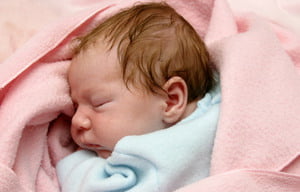Always consult your physician to diagnose infant skin conditions. They can recommend treatment options. What works for one condition may not be effective on another. In fact, certain infant skin conditions can worsen if treated improperly. That being said, as a mother of three and grandmother of four, I have certainly encountered my share of skin conditions in infants. Here are my personal recommendations for recognizing and treating them.
1. Eczema most often appears as a dry scaly rash. Skin may whiten around affected areas. This is not just dry skin, but mild cases do respond to dry skin treatments. I’ve found that infant eczema is best treated by starting with the gentlest method possible. Certain ingredients in prescription eczema ointments are not intended for long term use. One of these is cortisone. I used petroleum jelly as an eczema preventative between break-outs on my children and grandchildren. If prevention doesn’t help, it may be necessary to obtain a prescription ointment from your doctor.
2. Cradle cap is a very common infant skin condition. Many people don’t know what to think when the skin on their infant’s scalp starts crusting over. It can be pretty scary if you’ve never seen it before. Luckily, there is a very simple way to get rid of cradle cap. Simply massage olive oil into the baby’s scalp after each shampoo. The crusty build-up can be combed away when moisturized. Avoid the use of scented soaps and shampoos. These can aggravate and even cause cradle cap and dry skin.
3. Infant acne looks about the same as regular acne. It may seem strange to have a baby with acne. Actually, acne is quite common in infants. Sometimes infant acne is caused by allergies. Your doctor can tell you if this is the case. Preliminary treatment for this infant skin condition usually includes refraining from the use of scented soaps and lotions on your baby. You should also remember not to vigorously scrub your baby’s skin. If acne doesn’t go away in a reasonable length of time, consult your physician for further treatment options.
4. Diaper rash is fairly easy to recognize, since it generally appears in the diaper area. Diaper rash products containing zinc oxide are most effective. You can prevent most cases of diaper rash by using plain petroleum jelly or zinc oxide after changing and cleansing the diaper area. Letting baby air out sans diaper, gives diaper rash a healing rest. Some babies are allergic to scented wipes. Using them may cause diaper rash. Watch for diaper rash that does not go away or worsens, despite treatment. This could be a yeast infection. Babies are prone to yeast infections due to the constant moist environment of the diaper. Baby yeast infections require prescription medicines specifically for infants. Do not try to treat them with adult over-the-counter creams.
5. Heat rash happens when baby’s skin under their clothing becomes hot and moist. It goes away quite readily when this issue is remedied. Heat rash is most common in summer months. I have seen it occur in winter when overzealous parents bundle babies up unnecessarily. It’s important to keep your baby both warm and dry. Over-dressing encourages perspiration. Treat heat rash by bathing baby to cool skin and rinse off perspiration. Dress your baby in weather-appropriate clothing. They should be comfortable, not over-heated. Infant skin conditions can be easily treated with commonsense tips like these and advice from your baby’s doctor.
More from this contributor:
First Aid Necessities for Infants and Children
Breastfeeding Helps New Moms Lose Weight Faster and Avoid Diabetes
What Do I Do If My Baby Stops Breathing?




